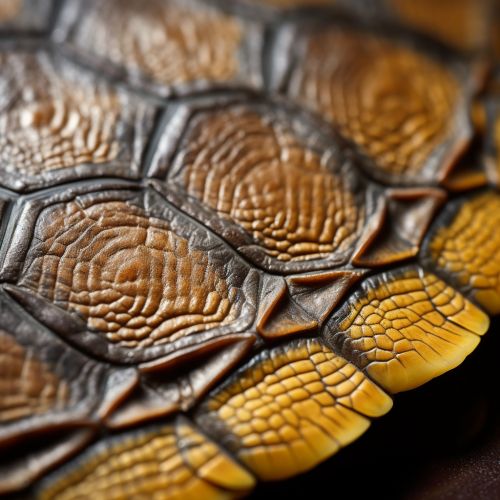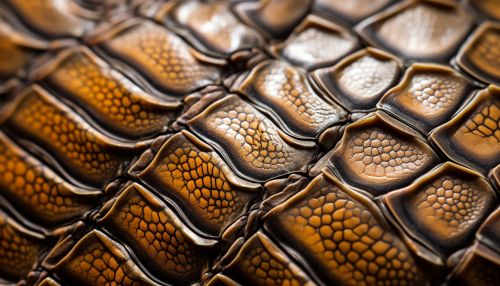Turtle Shell
Anatomy
The turtle shell is a highly complex shield for the ventral and dorsal parts of turtles, tortoises, and terrapins, completely enclosing all the vital organs of the turtle and in some cases even the head. It is constructed of modified bony elements such as the ribs, parts of the pelvis and other bones found in most reptiles. The bony shell is covered by a layer of epidermis.


The shell is made up of about 60 bones that are covered by plates called scutes. These scutes are made of keratin, the same material that makes up humans' nails and hair. The scutes protect the bones of the shell and prevent them from becoming brittle.
Evolution
The evolution of the turtle shell goes back to the early Triassic period. The oldest fully shelled turtle is the late Triassic Proganochelys, though its shell is different from modern turtles in that it had teeth and could not withdraw its head, but had a neck retraction of a more vertical than horizontal motion. Other early turtles are partially shelled, like Eunotosaurus and Pappochelys. The turtle shell evolved from bony extensions of the backbone and ribs which expanded and grew together to form a complete shell that offered protection at every stage of its evolution, even when the bony component of the shell was not complete.
Function
The turtle shell has a number of uses or functions depending on the species of turtle. For most turtles, the shell serves as a protection from predators. Some turtles, such as the Box Turtles, can close their shells completely. Other turtles cannot close their shells, like the Sea Turtles, but their shells are streamlined to aid in swimming and diving.
The shell also plays a vital role in the turtle's physiology, as it is part of the turtle's respiratory system. The rigid shell of the turtle restricts the movement of the chest, making it difficult for the turtle to breathe using the same method as other animals. Instead, turtles have developed a unique method of respiration: they draw air into their lungs through a process called buccal pumping.
Structure
The turtle shell is divided into two sections: the carapace (the dorsal, or back, portion) and the plastron (the ventral, or belly, portion). The carapace and plastron are joined on the turtle's sides by bony structures called bridges. The inner layer of a turtle's shell is made up of about 60 bones that include portions of the backbone and the ribs, meaning the shell is an integral part of the skeleton.
The carapace is made up of 10-13 lateral scutes on each side, depending on the species. Each scute corresponds to a single vertebra. The plastron usually has 12 plastral scutes. The scutes are made of keratin and are not attached to the bone, but sit on top of it like a cap.
Variation
There is a great deal of variation in the shape and color of the turtle shell. Some turtles have a dome-shaped shell, others have a flat shell. The color of the shell can vary from black to green, brown, and yellow. Some turtles have shells with intricate patterns, others have plain shells.
The size of the shell also varies greatly among species. The smallest turtle species have shells that are only about 3-4 inches long, while the largest species, the Leatherback Sea Turtle, can have a shell that is over 6 feet long.
Human Use
Throughout history, humans have used turtle shells for various purposes. In many cultures, turtle shells were used in making musical instruments, especially percussion instruments such as the turtle shell rattles. They were also used in ceremonial practices by Native American tribes.
In some parts of the world, turtle shells have been used in medicine. In traditional Chinese medicine, the shell of the turtle, known as Gui Ban, is used in various treatments.
Conservation
Many species of turtles are threatened or endangered, and the trade in turtle shells has been a major factor in their decline. The international trade in turtle shells is regulated by the CITES, and it is illegal to import or export turtle shells without a permit.
Despite these regulations, the illegal trade in turtle shells continues, and many species of turtles are still at risk. Conservation efforts are focused on protecting turtle habitats, enforcing existing laws, and educating the public about the importance of turtles and the threats they face.
